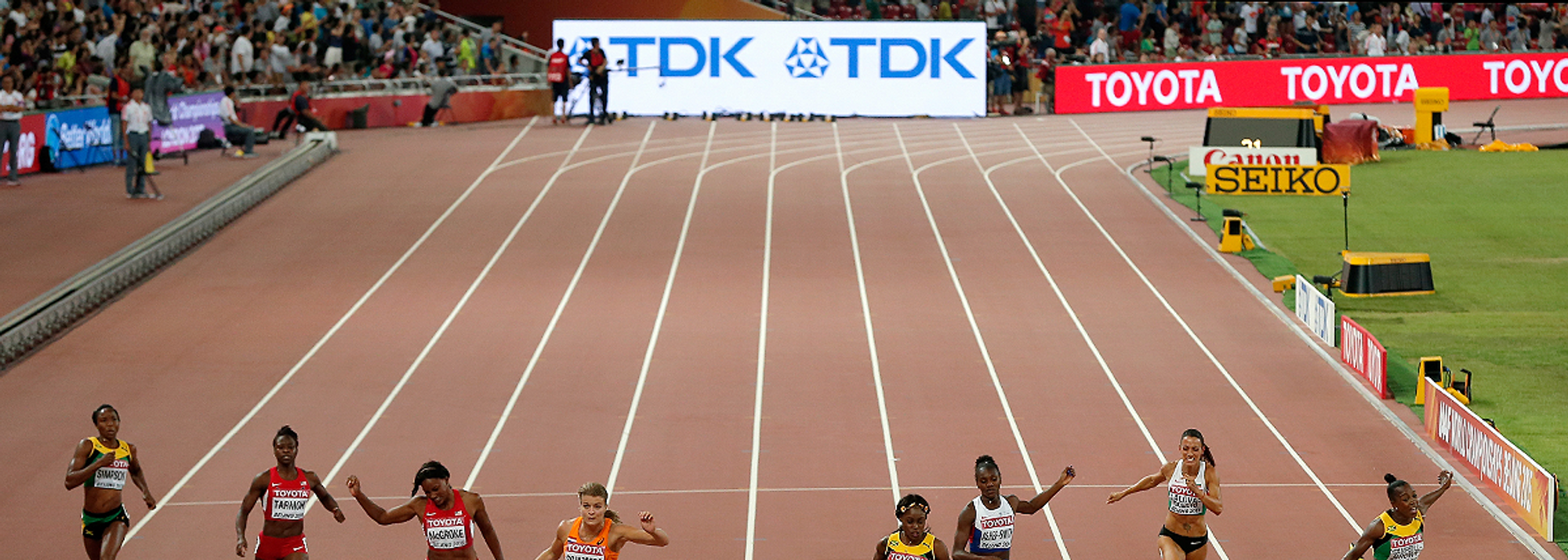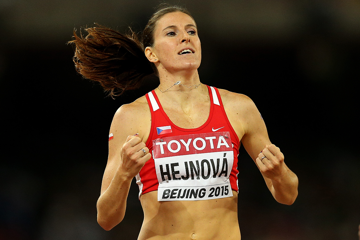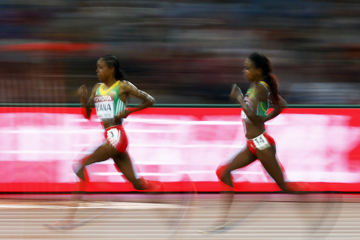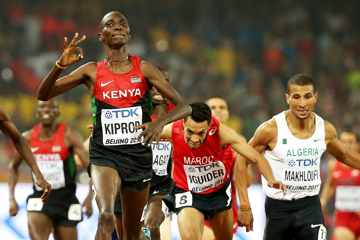Dafne Schippers wins the 200m title at the IAAF World Championships Beijing 2015 (© Getty Images)
Statisticians A Lennart Julin and Mirko Jalava look back on the best sprint performances of the year.
Men’s 100m
Since returning four years ago, Justin Gatlin had been getting ever closer to Usain Bolt. In 2011 Gatlin’s best coming into the World Championships was 9.95, in 2013 it was 9.89 and in 2015 it was 9.74 – backed up by three other comfortable IAAF Diamond League wins of 9.75, 9.75 and 9.78.
Not even Bolt had ever had more than two sub-9.80 clockings in the lead-up to a major championships. This year he had competed just twice in the 100m, winning in 10.12 and 9.87. For the first time since Bolt’s rise to the top in 2008, a dethroning of the king looked likely.
But in the end what matters is what you produce on that given day. Once more Bolt managed to raise his game on the occasion. He may not have reproduced his vintage form, but with Gatlin folding technically in the closing metres, Bolt squeezed out a photo-finish win, 9.79 to 9.80.
Mike Rodgers, Tyson Gay and Asafa Powell, all in their thirties, were expected to compete for the bronze. But the trio ended up in fifth, sixth and seventh respectively. Third place was shared by Canada’s Andre de Grasse and USA’s Trayvon Bromell, both aged just 20 and both having had their main focus on the US collegiate scene several months earlier.
The 100m once more was dominated at the top by USA and Jamaica who claimed six of the top seven athletes in the World Championships final. But they are fast gaining company in the elite echelon: 2015 brought all-time high figures for sub-10 performers (27) and nations (10).
Men’s 200m
Both Usain Bolt and Justin Gatlin competed sparingly in this event with just three meetings each before the World Championships. One minor pre-season race and one IAAF Diamond League meeting each was supplemented by Ostrava for Bolt and the US Trials for Gatlin. As in the 100m, Gatlin had a big advantage timewise coming into Beijing with a best of 19.57 compared to Bolt’s 20.13.
But a different Bolt showed up at the Bird’s Nest. With his best race in two years, he already led Gatlin coming off the bend and went on to win comfortably in a world-leading 19.55.
With Bolt and Gatlin running just once each in the IAAF Diamond League, the main contenders were Alonso Edward, Zharnel Hughes and Anaso Jobodwana. Those three also proved themselves in Beijing by finishing fourth, fifth and third respectively.
Hughes, aged 20, provided the main challenge from the next generation at the World Championships as Andre De Grasse chose to focus on the 100m. De Grasse had previously demonstrated exciting 200m potential by winning the NCAA title in a wind-assisted 19.58 and the Pan American Games in 19.88.
This year also saw the return to top form for Ramil Guliyev. Since finishing seventh at the 2009 World Championships at the age of 19, Guliyev had struggled, but he finished sixth in Beijing and later lowered his PB to 19.88.
His former junior rival Christophe Lemaitre suffered opposing fortunes this year. Having finished third at the 2011 World Championships and sixth at the 2012 Olympics, the French sprinter did not progress beyond the semi-finals in Beijing.
Men’s 400m
This year was one for the history books.
Up until 2015, only 10 runners – nine from the USA and one from Grenada – had run faster than 44 seconds. In 2015 alone there were six from six different nations.
The 2015 400m revolution was not just restricted to the very top. Between 2000 and 2014 the yearly number of sub-44.50 runs varied between 1 and 7 and the number of sub-45s between 16 and 23. But in 2015 the numbers suddenly more or less doubled to 14 sub-44.50 and 34 sub-45.
A significant component in this revolution is that the traditional US monopoly has been broken. Beijing saw only one US runner among the eight finalists. The top 10 performers on the world list are from 10 different nations, and there are only four US runners in the top 25.
That shift in the power balance is due to the rest of the world significantly improving. The USA’s top runner, 2008 Olympic and two-time world champion LaShawn Merritt, set a PB of 43.65 in Beijing but still had to be content with the silver.
World champion Wayde van Niekerk and Olympic champion Kirani James are just 23, but they still have to be aware of a group of runners aged 20 or younger that this year closed in fast on the 44-second barrier: Machel Cedenio, Steven Gardiner, Abdalaleh Haroun and Javon Francis.
Women’s 100m
World and Olympic champion Shelly-Ann Fraser-Pryce continued her trend of producing strong performances during major championships seasons.
Her 2014 outdoor season was a quiet one, but in 2015 the Jamaican came back big. After a disappointing 11.25 opener in Shanghai in mid-May, the 28-year-old returned to her usual form at the IAAF Diamond League meeting in Eugene in late May. A world-leading 10.81 was followed by another world lead of 10.79 at the National Championships and 10.74 in Paris in July.
In Beijing, Fraser-Pryce won her second straight and third overall world title in 10.76, holding off a late surge from fast-finishing Dutchwoman Dafne Schippers. The double European champion set a 10.81 national record for the silver and seemed genuinely surprised after the race.
The 23-year-old was strong prior to Beijing, setting national records of 10.94 and 10.92 when winning in Hengelo and London respectively, but many suspected she was not yet ready to win a 100m medal in Beijing.
US champion Tori Bowie ran 10.86 to take the bronze in Beijing, her first major medal, just 0.05 off the personal best she set at the US Trials, but other US sprinters disappointed in Beijing.
English Gardner and Jasmine Todd, 10.79 and 10.92 performers this year, were unable to reach the World Championships final.
Nigeria’s Blessing Okagbare enjoyed a strong season with a 10.80 season’s best in Paris before finishing eighth in Beijing. But early world leader Murielle Ahoure did not fare so well in Beijing. The 28-year-old set a 10.81 national record in Eugene, but a 10.98 run in the Beijing semi-final was not enough for the final.
Women’s 200m
The season started with a fast early world lead of 21.98 by Allyson Felix in Doha. The US sprinter decided, however, not to pursue this event in Beijing and with Shelly-Ann Fraser-Pryce, the 2013 world champion, coming to the same conclusion, the field in this event was wide open for the World Championships.
Since the early sub-22-second mark by Felix, the fastest performance heading to Beijing was Candyce McGrone’s 22.08 in Monaco. The 26-year-old finished second at the US Trials and was close to the medals in Beijing, recording a 22.01 personal best in the final for fourth place, the fastest time ever to miss out on a medal at the World Championships.
Dafne Schippers was always thought to have a better shot at a medal in the 200m than the 100m, and in Beijing, having already won a medal at the shorter distance, she was considered a clear medal favourite over 200m.
Her 22.03 national record in Zurich in 2014 showed she knew how to run fast, although her best time in 2015 before the World Championships was a little slower than that, 22.09 in Monaco in July. The 23-year-old qualified easily to the final, but the fireworks in the final in Beijing was unprecedented.
Jamaica’s Elaine Thompson started the season with only a 23.23 personal best, which the 23-year-old lowered to 22.10 when winning at the IAAF Diamond League meeting in London in July. Thompson, despite her inexperience in this event, clearly led for most of the way in Beijing, but this time Schippers’ push in the final 20 metres was just enough to win in a championship record of 21.63. Her mark was also European record, erasing the 21.71 that was shared between Germany’s Marita Koch and Heike Drechsler.
Thompson took the silver with a huge personal best of 21.66, cutting a total of 1.57 seconds off her pre-season PB, while two-time Olympic champion Veronica Campbell-Brown was third in 21.97.
Another record fell with Britain’s Dina Asher-Smith setting a world age-19 best of 22.07 for fifth place, erasing Kathy Cook’s national record of 22.10 which had stood since the 1984 Los Angeles Olympics.
Women’s 400m
The 400m season was a weird one.
The best pick for the world title based on early season form did not even make the US team. World indoor champion Francena McCorory ran a world-leading 50.13 at the Drake Relays in her first race of the season and followed that with impressive IAAF Diamond League wins in Doha, Rome and New York, setting a world lead of 49.86 at the latter.
But after running another world lead of 49.85 in the semi-finals of the US Trials, the 27-year-old finished fourth in the final in 50.88 and missed out on making the team. Olympic champion Sanya Richards-Ross, who ran 49.95 in Kingston in May, did not even make the final at the US Trials.
McCorory improved her own world-leading mark to 49.83 in Monaco, but with the fastest athlete out of the picture heading to Beijing, 2011 world silver medallist Allyson Felix and Bahamian Shaunae Miller, who set a personal best of 49.92 when winning in Lausanne in July, were the favourites. Felix had run 50.05 before Beijing, but her PB of 49.59 from the 2011 World Championships suggested she could go considerably faster.
Felix went out hard in the Beijing final and by half way there was little doubt she would win. She took gold – her ninth outdoor world title – in a world-leading 49.26.
Miller, who had finished fourth in the 200m in Moscow two years prior, ran an extremely balanced race, finishing fast to grab the silver in a PB of 49.67. Jamaica’s Shericka Jackson took bronze in 49.99.
A Lennart Julin (men’s events) and Mirko Jalava (women’s events) for the IAAF







